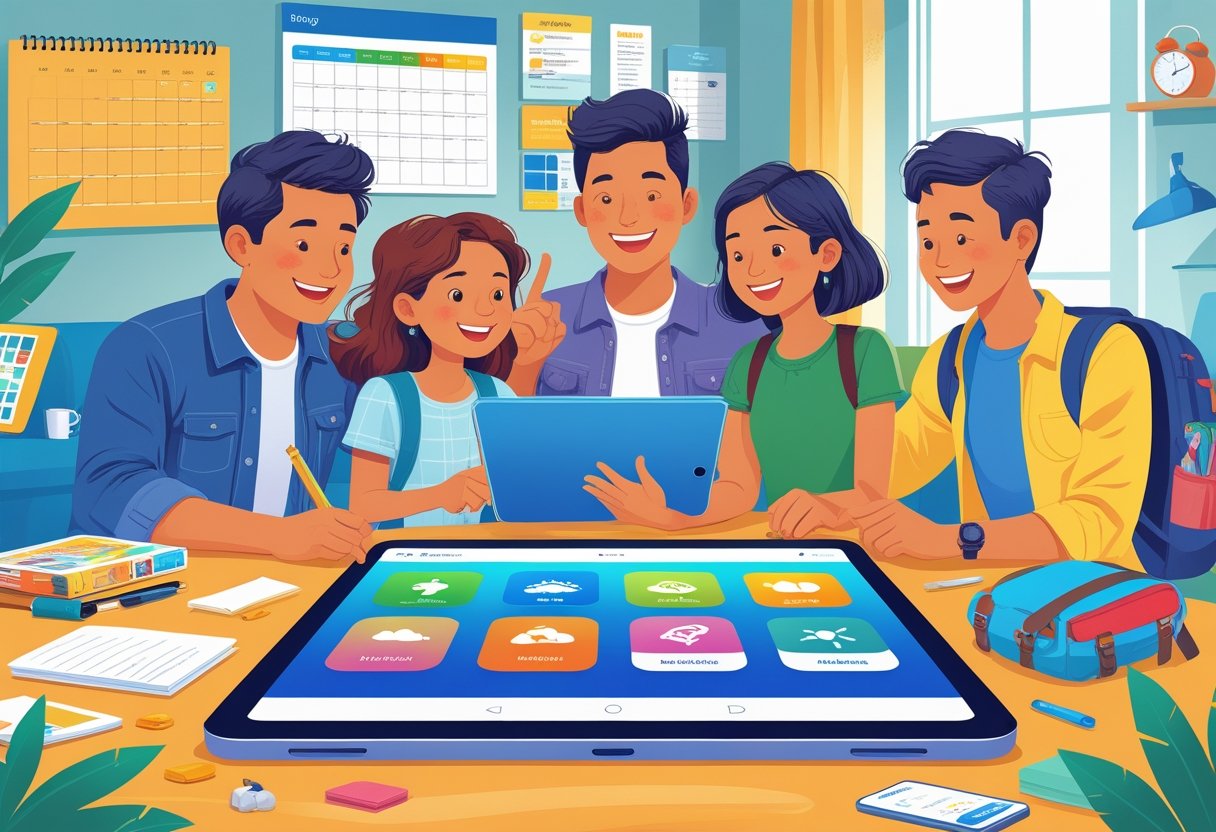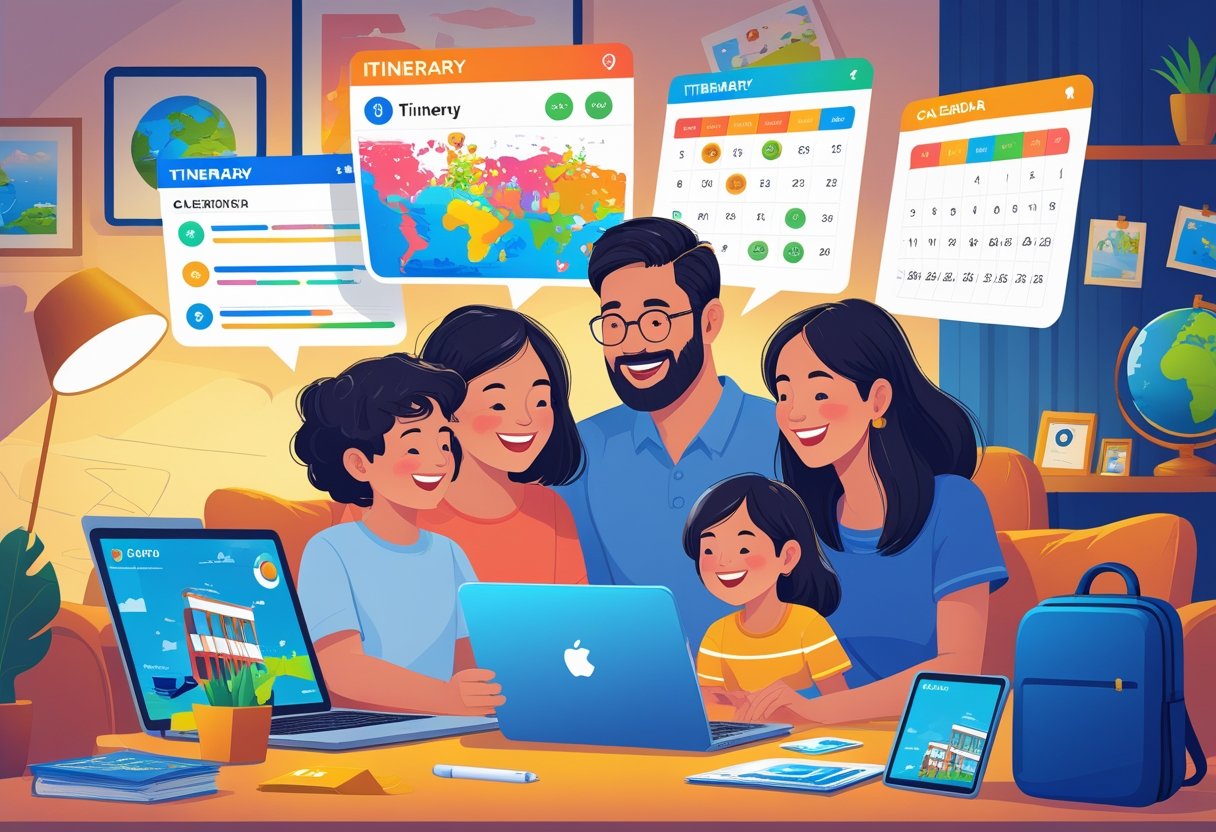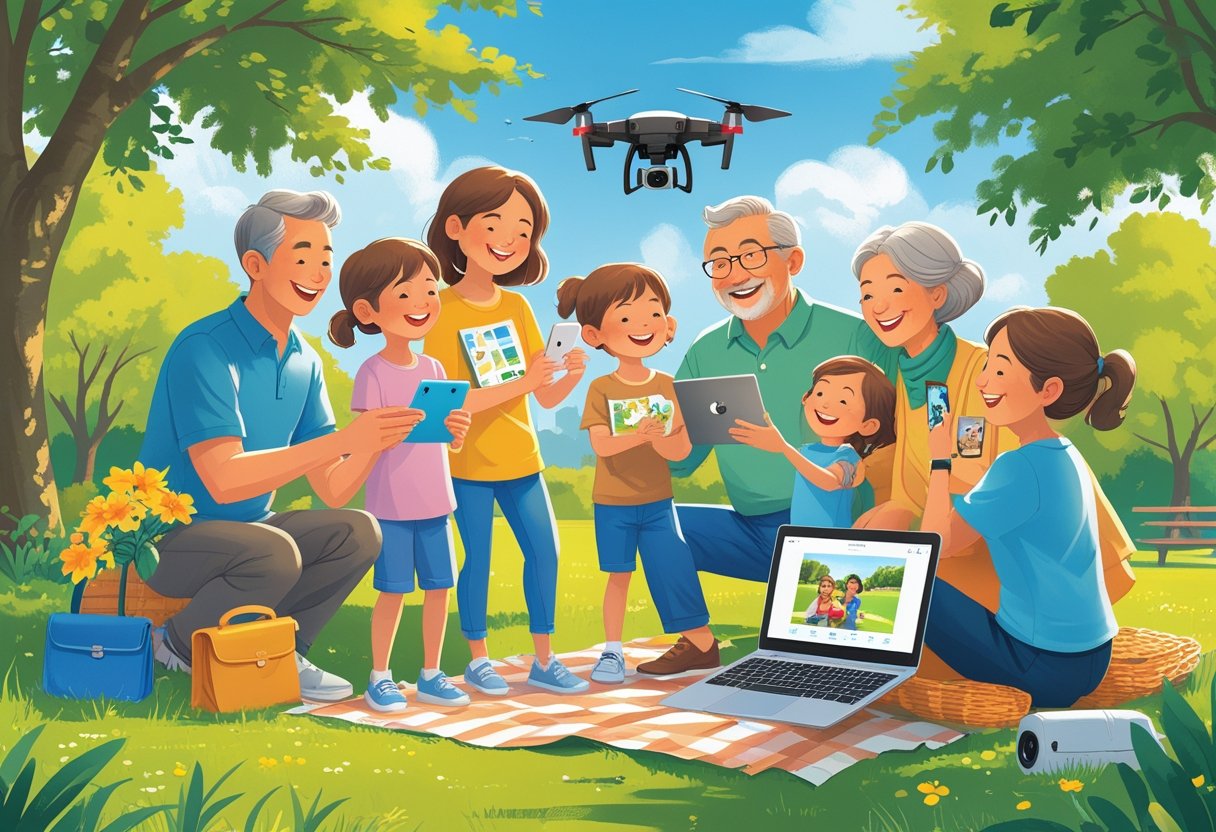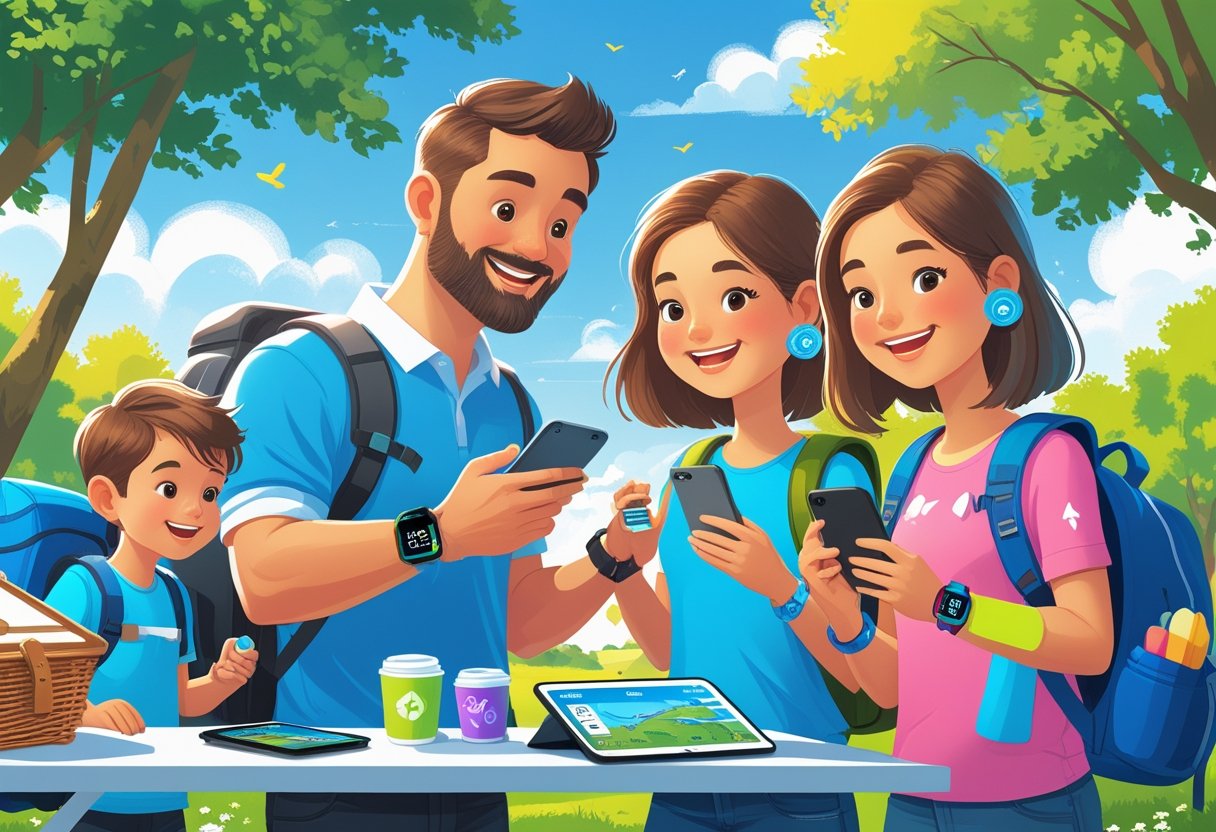Planning family outings has evolved significantly with the integration of technology in our lives. I’ve found that using digital tools not only simplifies the planning process but enhances the overall experience for everyone involved. Technology can transform ordinary family outings into extraordinary adventures by helping you discover hidden gems, manage logistics efficiently, and create lasting memories through photos and videos.

The right tech tools can take the stress out of coordinating schedules, finding activities that appeal to different age groups, and navigating to destinations. From interactive map applications to crowd-sourced review platforms, we now have unprecedented access to information that makes planning more collaborative and engaging for the entire family.
Key Takeaways
- Digital planning tools can help you discover unique destinations, manage complex itineraries, and find family-friendly activities that everyone will enjoy.
- Technology enables shared family experiences through games, photo sharing, and collaborative planning that brings everyone closer together.
- Balancing technology use with unplugged time ensures your family outings remain meaningful connections while still benefiting from digital convenience.
The Benefits of Leveraging Technology for Family Outings

Technology has revolutionized how we plan and enjoy family time together, offering tools that make outings more meaningful and less stressful. Digital solutions help families stay connected while providing practical advantages for organization and safety.
Strengthening Family Connections
Technology provides unique opportunities to build stronger family bonds during outings. Family members can document early learning activities and special moments using smartphones or cameras, creating lasting memories to revisit later.
I’ve found that collaborative planning apps allow everyone to have input on destinations and activities, making children feel valued and included. This shared decision-making process often leads to greater excitement and engagement from all family members.
Video calls enable distant relatives to participate virtually in special outings, from zoo visits to nature hikes. These shared moments of exploration and entertainment help build connections despite physical distance.
Interactive scavenger hunts using smartphone apps can transform routine outings into adventures that encourage communication and teamwork among family members of all ages.
Saving Time and Reducing Stress
Planning tools and apps significantly reduce the preparation burden for family outings. I can research destinations, check reviews, and make reservations all from one device, eliminating the need for multiple phone calls or visits.
Real-time traffic apps help me avoid congestion and find the quickest routes, saving valuable family time and preventing frustration before the fun even begins.
Weather forecasting applications allow for better preparation and timing of outdoor activities. I can pack appropriate clothing and sometimes reschedule when conditions might impact our experience.
Digital tickets and contactless payment options eliminate the stress of printing documents or carrying cash. Everything I need is securely stored on my phone for quick and easy access.
Meal-finding apps help locate family-friendly restaurants near our destination, preventing the classic “where should we eat?” debate that can derail an otherwise perfect outing.
Enhancing Safety and Convenience
Location-sharing features provide peace of mind when family members temporarily separate during outings. I can quickly locate my child in a crowded venue without panic or confusion.
Emergency information apps store vital medical details, contact numbers, and nearby facility locations, ensuring I’m prepared for unexpected situations while away from home.
Technology offers a lifeline for families traveling in unfamiliar areas through translation apps and GPS navigation. I never worry about getting lost or facing communication barriers.
Digital photography allows me to capture important information like parking locations or meeting points. These visual reminders prevent confusion and save time when navigating large venues.
Wearable devices help monitor children’s locations and even vital signs during physically demanding activities, allowing me to ensure their safety while still giving them independence to explore.
Essential Apps and Platforms for Outing Planning

Technology has revolutionized the way I plan family outings, making coordination seamless and activities more memorable. The right digital tools can transform a potentially stressful planning process into an enjoyable experience while ensuring everyone’s preferences are considered.
Travel and Navigation Tools
I’ve found Google Maps to be indispensable for family outings. Beyond basic directions, it offers real-time traffic updates, alternative routes, and even public transit schedules in most locations.
For road trips, Waze provides crowd-sourced traffic information and alerts about accidents, construction, or police activity ahead. This helps me avoid unexpected delays when traveling with impatient children.
When exploring new cities, CityMapper offers comprehensive transit information including subway maps, bus routes, and even bike-sharing options. It excels in calculating multi-modal routes that Google Maps might miss.
For families who enjoy hiking, AllTrails provides detailed information on thousands of trails, including difficulty levels, elevation profiles, and user reviews. I can download maps for offline use when venturing into areas with poor cell coverage.
Event Discovery and Booking Apps
Eventbrite has become my go-to platform for discovering and booking family-friendly events. It offers filters for kid-appropriate activities and often provides early-bird ticket discounts.
Local tourism apps like Visit [City Name] typically highlight seasonal attractions and special events that might not appear on broader platforms. Many offer digital passes that bundle multiple attractions at discounted rates.
For outdoor adventures, Reserve America simplifies booking campgrounds and outdoor facilities in national parks and recreation areas. Booking in advance is essential for popular destinations, especially during peak seasons.
When planning museum visits, I use specific museum apps that offer interactive maps, highlight kid-friendly exhibits, and sometimes provide discounted tickets for off-peak hours. Many large museums also offer audio guides tailored specifically for children.
Weather and Safety Alerts
AccuWeather provides detailed hourly forecasts and precipitation alerts that help me plan outdoor activities with greater confidence. Their MinuteCast feature predicts start and stop times for rain with surprising accuracy.
For more severe weather concerns, the FEMA app delivers real-time alerts about natural disasters and provides emergency preparation checklists tailored to different scenarios. This gives me peace of mind when traveling to unfamiliar areas.
UV Lens tracks ultraviolet radiation levels throughout the day, reminding me when to reapply sunscreen or seek shade. This is especially helpful for beach outings or extended outdoor adventures with children.
When hiking in remote areas, I rely on Emergency SOS features built into smartphones. Additionally, standalone apps like what3words can communicate precise locations to emergency services using just three words, even in areas without street addresses.
Group Coordination Solutions
Calroo stands out as a specialized family scheduling app that allows parents to assign tasks, set reminders, and share schedules seamlessly. Its color-coding system helps everyone keep track of individual responsibilities.
For complex outings involving extended family or friends, I use WhatsApp groups to share itineraries, coordinate meeting points, and distribute photos in real-time. Creating dedicated groups for specific events prevents information overload.
Trello helps me organize larger gatherings with its intuitive card-based system. I create separate cards for transportation, accommodations, activities, and meal plans, allowing family members to comment and contribute ideas.
Expense-sharing apps like Splitwise have eliminated awkward money conversations during multi-family outings. We simply enter expenses as they occur, and the app calculates who owes what at the end of the trip.
Creating Customized Itineraries with Digital Tools

Digital tools have revolutionized family trip planning, eliminating the need for paper maps and handwritten lists. I’ve found that the right apps and platforms can transform chaotic family outings into seamless adventures that everyone will enjoy.
Interactive Mapping and Route Planning
Modern mapping tools offer far more than basic directions. I use AI-powered planning platforms to visualize entire day trips at once, including estimated travel times between attractions. This helps me avoid the common mistake of scheduling too many activities in a single day.
When planning with children, I mark kid-friendly restrooms and snack stops along routes. These seemingly small details prevent many meltdowns!
For city explorations, I create custom Google Maps with color-coded pins for different categories:
- 🍦 Kid-friendly food spots
- 🌳 Parks and playgrounds
- 🚻 Public restrooms
- 🅿️ Parking options
These interactive maps can be downloaded for offline use, which I’ve found essential when traveling to areas with spotty cell coverage.
Collaborative Scheduling Features
Family planning works best when everyone contributes ideas. I use travel planning tools with collaborative features that allow each family member to suggest activities.
Many platforms include voting systems where family members can rank preferred activities. This democratic approach helps avoid the “I didn’t want to do this anyway” complaints during the actual outing.
I’ve found that digital tools like Trello or specialized travel apps help visualize time blocks clearly. This prevents overscheduling and builds in essential downtime for younger children.
Setting up automatic reminders for reservation times has saved our family from missing scheduled activities multiple times. Most tools now integrate with calendar apps to send timely alerts.
Syncing Plans Across Devices
The true power of digital planning emerges when all family members can access the itinerary on their own devices. I ensure our plans sync across all family devices so everyone stays informed.
Cloud-based itineraries allow real-time updates when plans inevitably change. I’ve found this flexibility crucial when dealing with weather changes or unexpected closures.
Many modern planning tools offer offline access modes, ensuring we can view our schedule even without internet connection. This feature has proven invaluable in remote locations.
I use platforms that send push notifications for schedule changes to all connected family members. This prevents confusion when last-minute adjustments are needed.
For older children with their own phones, I implement location sharing during outings. This provides peace of mind in crowded venues while giving teens a sense of independence.
Tech Tips for Capturing and Sharing Family Memories

Modern technology offers incredible tools for preserving family experiences beyond the moment they occur. These digital solutions help families document adventures, share moments securely, and organize memories in accessible formats that can be revisited for years to come.
Photography and Video Apps
The right photography apps can transform ordinary family outing photos into stunning keepsakes. I recommend trying ProCamera or Halide for iPhone users seeking DSLR-quality shots without carrying bulky equipment. For Android, Moment Pro Camera offers similar professional controls.
For capturing active children, burst mode features (available on most native camera apps) are invaluable. Simply hold down the shutter button to take multiple shots in succession, ensuring you’ll catch at least one perfect moment.
Video creation apps like Quik or CapCut automatically compile your day’s footage into engaging highlight reels. These apps include templates specifically designed for family adventures that add music and transitions with minimal editing effort.
Time-lapse features work brilliantly for documenting longer activities like building sandcastles or hiking trails. The compressed video tells the complete story in seconds.
Private Sharing Platforms
Family memories deserve protection while being easily accessible to loved ones. FamilyAlbum offers dedicated space for privately sharing children’s photos and videos with specified family members only. No public viewing or data mining occurs.
For cross-platform families, Google Photos provides robust private sharing options. Create shared albums where multiple family members can contribute photos from the same outing, regardless of their device type.
Family communication platforms like Marco Polo allow relatives to exchange video messages about shared experiences, creating an ongoing conversation around your memories.
For distant relatives, scheduled virtual viewing parties using platforms like Watch2Gether let everyone enjoy vacation videos simultaneously while video chatting. This creates a shared experience even when physically apart.
Organizing Digital Albums
Digital clutter can make finding specific memories frustrating. I recommend establishing a consistent naming convention for all family outing folders (e.g., “Location-Date-Event”) to streamline future searches.
Cloud storage with automatic categorization features saves time. Google Photos and Apple Photos both use AI to identify people, places, and even activities, making specific memories easy to locate years later.
Creating digital storytelling projects adds meaningful context to your photos. Apps like StoryCorps let family members record audio narration explaining the significance of certain memories, adding emotional depth to visual records.
Consider quarterly digital cleanup sessions where the family reviews recent memories together. This practice helps identify favorite photos for physical printing while deleting unnecessary duplicates that consume storage space.
Smart Gadgets and Wearables for Outing Success

Modern technology offers incredible tools to enhance family outings, keeping everyone safe, connected, and engaged. The right devices can transform an ordinary family trip into a seamless adventure.
GPS Trackers for Safety
When exploring new locations with children, safety remains my top priority. I’ve found that smart wearables like badges and wristbands provide peace of mind during crowded outings. These devices allow me to monitor my children’s locations in real-time through smartphone apps.
Many GPS trackers offer geofencing features that alert me if a child wanders beyond a designated area—perfect for busy theme parks or hiking trails. Some models include emergency SOS buttons that children can press if they become separated from the group.
I recommend water-resistant options for beach trips and waterparks. Battery life is another crucial factor—look for devices offering at least 24 hours of continuous tracking. Models like kid-friendly smartwatches blend safety features with fun elements, making children more willing to wear them.
Portable Chargers and Connectivity Devices
Nothing ruins a family outing faster than dead device batteries when you’re trying to navigate, communicate, or capture memories. I always pack a high-capacity power bank (10,000+ mAh) that can recharge multiple devices throughout the day.
For remote destinations, I rely on portable WiFi hotspots to maintain connectivity. Many newer models can connect up to 10 devices simultaneously—supporting the entire family’s tech needs.
Essential connectivity gear:
- Multi-port power banks with quick-charge capability
- Solar chargers for extended outdoor adventures
- Pocket WiFi devices with flexible data plans
- Cable organizers to prevent tangled messes
Weather-resistant options prove invaluable during unexpected rain. I’ve learned that compact designs with integrated cables reduce bulk while ensuring I’m never searching for the right connector during critical moments.
Activity Monitors for Family Engagement
Activity trackers transform family outings into fun challenges while promoting healthy movement. Modern wearables like smartwatches track steps, distance, and even heart rate, creating friendly competition among family members.
I encourage everyone to set daily step goals during vacations. Some devices feature achievement badges specifically designed to motivate children. My family enjoys comparing statistics at the end of each day, celebrating who climbed the most stairs or walked the furthest.
Many fitness trackers designed for kids come in colorful designs with gamified interfaces. These make physical activity more engaging through virtual rewards and character progression.
For maximum engagement, I select waterproof models suitable for swimming and water activities. The latest trackers even monitor sleep quality, helping me ensure everyone gets proper rest during action-packed vacations.
Maximizing Value with Deals, Discounts, and Loyalty Programs
Smart planning involves finding ways to stretch your family entertainment budget through strategic use of technology. Modern apps and platforms offer numerous opportunities to save money while creating memorable experiences.
Finding Exclusive Promotions Online
I recommend setting up deal alerts on sites like Groupon and LivingSocial specifically for family attractions in your area. These platforms regularly offer 30-50% discounts on admission to museums, theme parks, and recreational activities.
Many attractions also offer exclusive online-only discounts through their websites or social media pages. I follow my family’s favorite destinations on Instagram and Facebook, where they often post limited-time promotional codes.
Email newsletters from local venues might seem like clutter, but I’ve found they contain valuable early-bird pricing and flash sales not advertised elsewhere. Creating a dedicated email folder for these promotions helps me quickly find deals when planning outings.
Mobile apps like Honey and RetailMeNot automatically search for valid promo codes during checkout, potentially saving 10-25% with minimal effort.
Utilizing Family-Friendly Platforms
Family entertainment centers increasingly focus on customer retention through loyalty programs that reward repeat visits. I always check if venues offer membership options or season passes, which typically pay for themselves within 2-3 visits.
Many modern loyalty programs now extend beyond monetary value to offer personalized experiences. I’ve found programs that provide priority access, exclusive events, and behind-the-scenes opportunities that make outings more special.
Family-specific apps like KidPass or Winnie aggregate kid-friendly activities with built-in discount options. I use these platforms to discover new venues while automatically applying available savings.
Location-based deal apps like Dosh or Ibotta provide cashback for in-person spending. I simply link my credit card, make qualifying purchases, and receive automatic rebates of 3-8% at participating family venues.
Balancing Screen Time and Digital Well-Being
Technology helps us plan amazing family outings, but it’s important to set limits so screens don’t dominate our family experiences. Creating intentional practices around device usage ensures technology enhances rather than detracts from quality time together.
Setting Boundaries for Device Usage
Establishing clear rules about when and how devices can be used during family outings is crucial. I recommend creating a regular routine for screen time that everyone understands before leaving home.
Consider designating specific tech-free zones or times during your outing. For example, meals can be device-free to encourage conversation and connection.
I’ve found that setting time limits works effectively – perhaps allowing 15 minutes of device time after each hour of screen-free activities. This provides a balanced approach that children can understand.
Creating tech-free zones in natural settings helps everyone appreciate the environment more fully. Parks, beaches, and hiking trails offer perfect opportunities to disconnect completely.
Promoting Mindful Tech Habits During Outings
I encourage using technology purposefully during family activities. When devices are necessary, try using them collaboratively – perhaps looking up information about a historical site together rather than scrolling individually.
Photography can be a mindful tech activity when approached thoughtfully. Designate specific photo moments rather than constant documentation. This helps everyone stay present while still capturing memories.
Consider planning outdoor activities that are engaging enough to naturally reduce the desire for screen time. Family games, scavenger hunts, or nature exploration provide exciting alternatives.
Digital wellness means modeling healthy habits myself. When I put my phone away and engage fully, children naturally follow this example. This balanced approach to digital technology teaches children that devices are tools, not necessities.
Frequently Asked Questions
Technology provides numerous tools and resources to enhance family outings, from planning stages to capturing memories. These FAQs address common concerns about integrating tech into family adventures while maintaining balance and maximizing enjoyment.
What are the best mobile apps for organizing family trips?
I’ve found several apps particularly useful for family trip planning. TripIt stands out by organizing all reservations in one place, creating a comprehensive itinerary automatically from confirmation emails.
Google Maps has been invaluable for plotting routes with multiple stops and saving favorite locations. The offline map feature has saved my family numerous times in areas with poor reception.
For outdoor adventures, AllTrails helps me locate family-friendly hiking paths with detailed information on difficulty, elevation, and trail conditions. Planners like these can also help structure your approach.
How can technology enhance the experience of a family outing?
Audio guides and interactive museum apps have transformed our cultural visits by providing age-appropriate content that engages both adults and children. Many museums now offer dedicated apps with scavenger hunts and interactive elements.
Augmented reality apps bring historical sites to life, showing what ancient ruins looked like in their prime or revealing hidden stories about landmarks. My kids particularly enjoy this immersive form of learning.
Weather apps help me plan appropriate activities and pack accordingly, preventing many potential disappointments. Real-time updates have saved us from getting caught in sudden downpours on numerous occasions.
What online resources are available for finding family-friendly activities?
Local tourism websites typically feature comprehensive calendars of family events, seasonal activities, and local attractions with detailed information about accessibility and amenities.
Facebook community groups and event pages provide insider information about local happenings that might not be widely advertised elsewhere. I’ve discovered some of our favorite annual traditions through these resources.
Specialized platforms like TripAdvisor and Yelp offer filtered searches for family-friendly restaurants and attractions with reviews from other parents, giving realistic expectations about suitability for different age groups.
How can families manage screen time during outings while still leveraging technology?
I designate specific “tech times” during our outings – perhaps for navigation, taking photos, or learning about our destination – while keeping devices away during meals and primary activities. Having honest conversations about tech use helps set expectations.
Using airplane mode strategically allows access to downloaded guides and maps without the distraction of notifications and calls. This approach lets us use helpful technology without constant interruptions.
Modeling thoughtful device use by narrating my intentions helps my children understand appropriate technology use. For example, I’ll say “I’m using maps to find our next stop” rather than silently using my phone.
What are some tips for capturing and preserving memories from family outings using technology?
Creating a shared cloud album where family members can upload their photos provides multiple perspectives of the same event and ensures everyone has access to the memories regardless of which device captured them.
Time-lapse videos work wonderfully for documenting longer activities like building a sandcastle or watching a sunset, condensing hours into engaging short clips that capture the complete experience.
Voice memo interviews with family members about their favorite parts of the day create meaningful audio souvenirs that capture emotions and impressions in ways photos cannot. These recordings become increasingly precious over time.
How can social media and online communities contribute to planning family activities?
Pinterest has become my go-to resource for activity ideas, with boards dedicated to age-appropriate games, creative picnic concepts, and seasonal outdoor activities that can be filtered by location and interest.
Local parent groups on Facebook provide real-time recommendations and warnings about attractions, including practical details like parking availability, best times to visit, and insider tips for maximizing enjoyment.
Following location-specific hashtags on Instagram helps me discover photogenic spots and seasonal activities that might not appear in traditional tourism guides. User photos often provide a more realistic preview than official marketing materials.
